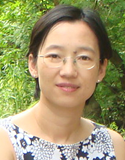
Associate Professor
Department of Cell Biology
Chanin Bldg., Room 302C
718.430.3339
Hilda.ye@einsteinmed.org
Research Interest
Publications
Biosketch
Lab Members
Online Journals
Protocols
Bioinformatics
Lymphoma Links
Online Books & Science Portals
|
|
Transcription Regulation and Cell Signaling Control in Normal B/T Cells and Lymphomas
Molecular pathogenesis of lymphomas situates at the crossroad of lymphocyte development, cancer genetics, transcription regulation, and cell signaling. Thus, we constantly draw upon the most recent advances in these fields to address mechanism questions that are related to lymphoma initiation and development. As each lymphoma entity often corresponds to a specific B/T cell activation/differentiation state that is phenotypically “frozen” by the malignant transformation process, our lymphoma-related studies also provide valuable insights to the regulatory mechanisms that govern the normal immune system. Our research has three major goals: to better understand mature B and T cell development in molecular terms, to decipher how this process is perturbed during lymphomagenesis, and to develop mechanism-based novel therapies to improve patient outcome.
The germinal center (GC) response is a very important B cell development stage that has the unique property of generating high affinity antibodies and B cell memory. Because dysregulated GC responses contribute to the development of B cell lymphomas and autoimmune diseases, in-depth understanding of the control mechanisms governing the GC response has both immunological and clinical implications. GCs are dynamic and specialized structures in the secondary lymphoid organs where the B cell genome is subject to two types of genetic alterations catalyzed by AID (activation induced cytidine deaminase), e.g. Ig class switch recombination and somatic hypermutation. Prior to their GC exit, B cells bearing mutated surface Ig molecules undergo positive and negative selections through interaction with two other types of cells in the GC, e.g. follicular dendritic cells follicular T helper (Tfh), and T follicular regulatory (Tfr) cells. Only the fittest B cells are licensed to terminally differentiate into memory or plasma cells. At the single cell level, the acquisition and termination of GC phenotype is the coordinated transcriptional response to various extracellular and intracellular stimuli; yet the precise sequence and nature of events that orchestrate this process is incompletely understood. We are particularly interested in the roles of two transcriptional factors, BCL6 and STAT3, both are known to play pivotal roles in fate specification and function of GC B cells, Tfh, and Tfr cells.
Our studies over the past 25 years have revealed novel mechanisms that govern the expression and activity of BCL6, and demonstrated the importance of functional interactions between BCL6 and several cell signaling pathways including RhoA, NF-B, and Jak/STAT3. In recent years, a central focus of our B cell lymphoma work was on the IL-6/Jak/STAT3 signaling pathway. With the help of our collaborators, we characterized expression regulation of STAT3, cause and consequences of its aberrant activity in diffuse large B-cell (DLBCL) development and therapeutic response. Functional contribution of this pathway to normal plasma cell maturation was also investigated.
Since three years ago, our work has taken on a new focus, i.e. the pathogenesis and immunologic features of adult T-cell leukemia/lymphoma (ATLL). ATLL is a rare CD4 T cell neoplasm, endemic in the Japanese, Caribbean and Latin American populations. It arises in HTLV-1 carriers and is an extremely aggressive cancer with a dismal outcome and lack of effective therapies. In a recently study published in Blood, we demonstrate that ATLL patients diagnosed in North American (NA-ATLL) have a distinct genomic landscape compared to the Japanese cohort (J-ATLL). In particular, NA-ATLL is characterized by a much higher frequency of prognostic epigenetic mutations and is targetable preclinically with DNA de-methylation drugs. Taking advantage of the fact that the Montefiore Medical Center follows one of the largest groups of ATLL patients in the U.S, we have built up a NA-ATLL Biobank, generated and characterized a number of novel NA-ATLL cell lines and PDX models to support our laboratory studies.
We are currently pursuing the following research questions:
1. Can the therapeutic outcome of the ABC subtype of DLBCLs be improved by manipulating the endogenous redox homeostasis of the lymphoma cells?
2. How does BCL6 contribute to the pathogenesis and transcription programs of NA-ATLL?
3. What is the genetic and clonal evolution basis that underlies the profound chemo-resistance of ATLL?
4. Explore novel, targeted therapies for NA-ATLL.
|